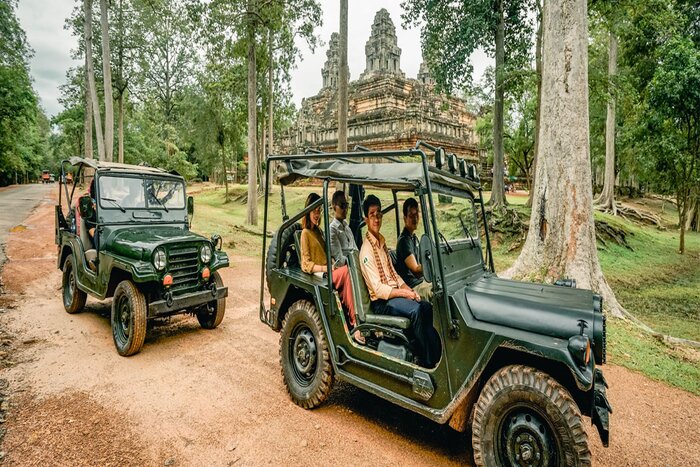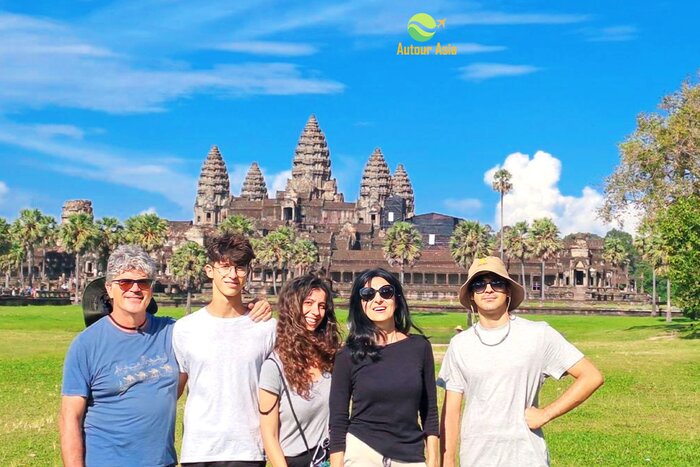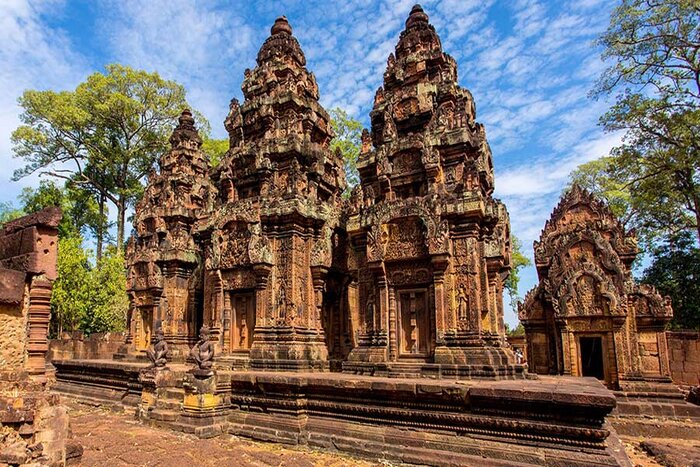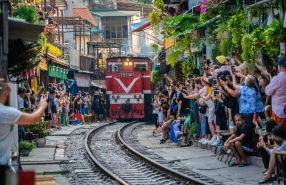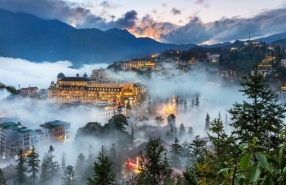Angkor Temple Complex, the majestic temple complex rising from the Cambodian jungle. It's a testament to human ingenuity, a portal to ancient civilizations, and a breathtaking spectacle that will leave you awestruck. But navigating this labyrinthine wonder can be daunting. Get your guide to the Angkor Temple Complex in Cambodia with Autour Asia to make your trip to Cambodia is an unforgettable experience.
I. Introduction General about the Angkor Wat Complex Temple?
1. What is Angkor Wat?
Angkor Wat (Angkor Temple Complex), located in Cambodia, meaning "City of Temples" in the Khmer language, is a temple complex in Cambodia and the largest religious monument in the world, covering 162.6 hectares. The building was initially built as a Hindu temple of the Khmer Empire, and gradually transformed into a Buddhist temple at the end of the 12th century, it served as a state temple and his eventual mausoleum. Its towering sandstone spires, intricate carvings, and sprawling galleries depict Hindu mythology and the journey towards enlightenment. Today, it remains a powerful symbol of Cambodia's rich history and cultural heritage. Angkor temple complex stands as a symbol of Cambodia's rich history and cultural heritage, attracting millions of visitors each year who come to marvel at its grandeur and immerse themselves in its mystical atmosphere.
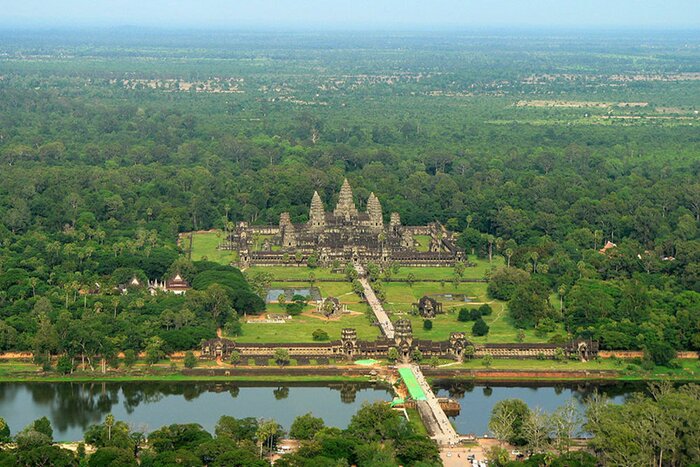
Whether you're an avid history buff, an architecture enthusiast, or simply someone seeking a glimpse into a lost civilization, this complex promises an unforgettable experience. From watching the sunrise paint the temple in golden hues to exploring the hidden corners of its galleries, prepare to be transported to a world of ancient wonders and spiritual serenity.
2. Get your guide to the Angkor Temple Complex in Cambodia
a.The best time to visit Angkor Complex
If you want to enjoy the peaceful surroundings of Angkor Wat, November to March is the best time. This season, Cambodia experiences a dry season, mild temperatures and clear skies make exploring Angkor Wat more enjoyable.
However, if you want to experience a different Angkor Wat, then from June to October is also a good choice when the weather also becomes cool for tourist activities. In particular, April is the time for the traditional Khmer New Year. Although the temperature can be quite high, you will witness and participate in unique and colorful festivals.
b. What is the best way to get to Angkor Wat?
Below are some suggestions for transportation around the Angkor temple complex that you can consider for your trip:
- By Tuk Tuk: This is the most traditional and popular means of transport in Cambodia. You will easily see them everywhere, especially around the Angkor temple area. The average price for a day of tuk-tuk rental ranges from 25 USD.
- By bicycle: Renting a bicycle is a great choice for those who want to enjoy the natural space, exercise, and explore Angkor temple freely. Bicycle rental prices are very affordable, only about 1 USD/day.
- Rent a car or private taxi: This is the best option if you want to avoid the heat and want to move quickly between locations. Car rental price for 1 day usually ranges from 30 - 40 USD.
c. Angkor Wat Entrance Fee
Angkor Wat offers one-day, three-day, and seven-day passes, with prices increasing for longer durations. Purchase your pass in advance to avoid queues at the entrance.
Entrance ticket price:
- Ticket for 1 day: 37 USD
- Ticket for 3 days: 62 USD (valid for 1 week)
- Ticket for 7 days: 72 USD (valid for 1 month)
Tickets must be purchased exclusively from the Angkor Ticket Office; avoid purchasing them from other sources. Once a ticket is acquired, it is non-transferable, and refunds are not permitted. In the event of a lost ticket, a new one must be purchased.
II. The architecture of the Angkor Temple Complex in Cambodia
Located in Siem Reap province, Cambodia, the Angkor complex is a large ancient architectural complex, including more than 600 works built from the 9th to the 15th century. This is one of the largest and most massive architectural complexes in the world and is one of seven World Heritage sites recognized by UNESCO.
The architectural wonder of Angkor perfectly blends Indian and Khmer cultural influences, showcasing structures largely crafted from sandstone and laterite, exuding a majestic and intricate splendor... The temple complex in cambodia is a combination of basic and sophisticated Khmer architecture. It is temple architecture with long, narrow corridors. The special mark of Angkor architecture lies in its meticulous design, reflecting the sacred Meru mountain that often appears in Hindu legends. The three-story main hall has a rectangular architecture located between a moat and a bridge. The wall is 3.6km long, connected by many deep corridors. The complex consists of 5 towers with a central tower and 4 square towers as the center of the throne. The structures at Angkor exhibit a pyramidal shape, characterised by multiple stacked levels, serving as an iconic representation of Mount Meru.
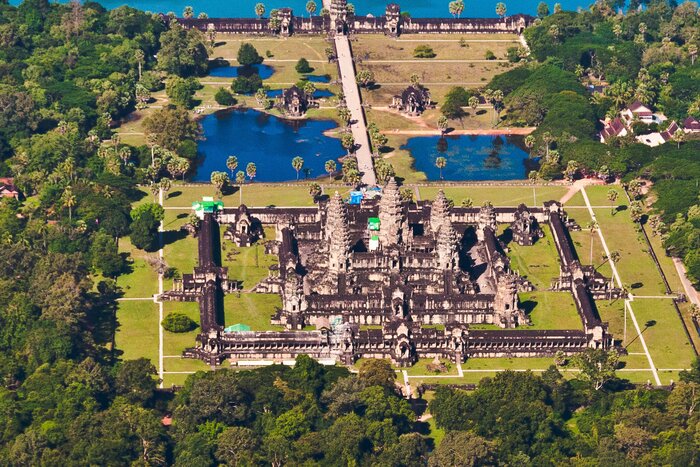
Another feature is the towers are a characteristic element of Angkor architecture. Towers are often built in the center of buildings, or at the corners, symbolizing protective gods. Another highlight of Angkor architecture is the exquisite reliefs. Angkor's buildings are decorated with many sophisticated reliefs, depicting scenes of daily life, war, religion,...
III. What's inside the Cambodia Temple Complex?
Angkor Wat is a sprawling complex, which has over 1,000 temples of different sizes and shapes bearing Khmer architectural style. So be prepared to see it! Below are some famous architectural works you might consider
1. Angkor Wat Temple
Angkor Wat Temple is the most prominent architectural work in the Cambodia Temple Complex. This is a captivating blend of Hindu and Buddhist influences, featuring sandstone terraces adorned with intricate carvings of celestial dancers and scenes from Hindu epics. The five lotus bud-shaped towers symbolize Mount Meru, the mythical abode of gods. Despite challenges, over 3000 beguiling apsaras, each with unique carvings and 37 hairstyles, grace its walls. Restoration efforts, like the German Apsara Conservation Project, are preserving these masterpieces.
This temple boasts a total of 398 rooms connected by a 1,500-meter-long corridor. Above, five interconnected towers stand in a tiered architectural structure, with the tallest tower reaching an impressive height of 65 meters and four subsidiary towers soaring to 40 meters. Each tower is divided into three symbolic levels: the first level represents the underworld or earth, the second symbolizes the human realm, and the third embodies the divine realm. The pathway leading to the main entrance of Angkor Wat is constructed with stone blocks, stretching 230 meters in length, nearly 10 meters in width, and positioned 5 meters above the water level of the surrounding moat.
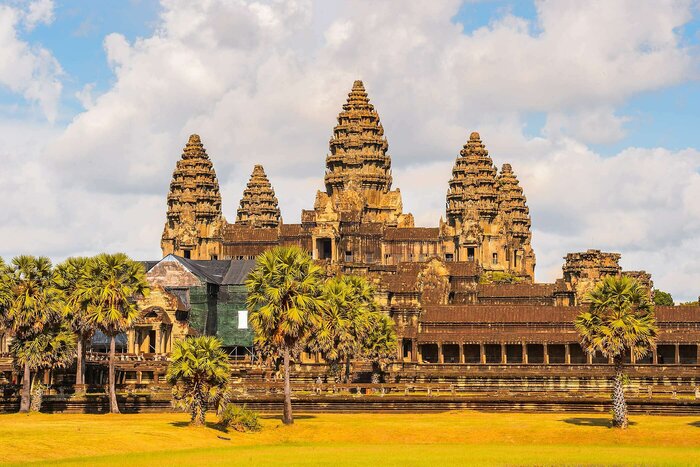
This meticulous design not only showcases the architectural prowess of the builders but also emphasizes the spiritual significance embedded in every aspect of Angkor Wat's structure. With its intricate carvings, symbolic towers, and harmonious layout, Angkor Wat stands as a testament to the rich cultural and religious heritage of Cambodia.
2. Angkor Thom
Get your guide to the Angkor temple in Cambodia by exploring the nearby "Great City" with its iconic Bayon temple, featuring giant rock faces overlooking the outside. A city with walls decorated with giant stone faces looks serenely through a moat filled with lotus flowers. This is Angkor Thom, the last and most enduring capital of the Khmer Empire, a place of ancient grandeur and vibrant life.
Step through the majestic South Gate, surrounded by towering guardians and guarded by mythical beasts. At its center, the mysterious Temple of Bayon rises, its mysterious faces radiating wisdom and compassion, their enigmatic smiles harboring the secrets of a forgotten age. Be prepared to discover intricate carvings that adorn every surface, depicting scenes from battles and royal ceremonies. Angkor Thom is more than just a collection of ruins, it is a testament to the enduring power of the imagination and a place where history whispers through every moss-covered stone.
3. Bayon Temple
Located in the center of the Angkor Thom complex, Bayon Temple is one of Cambodia's most famous temples. The temple was built in the 12th and early 13th centuries by King Jayavarman VII, with bold Buddhist architecture.
Bayon Temple has a total of 54 large and small towers, each tower is sculpted with 4 faces of the god Lokesvara, facing four different directions. This is one of the outstanding features of the temple, creating a unique and impressive beauty. According to Khmer beliefs, 54 towers in Bayon are considered lucky numbers according to astrology. These towers also represent the 54 provinces of the Khmer kingdom under King Jayavarman VII. For this reason, the towers here have uneven sizes, symbolizing the different large and small areas between provinces.
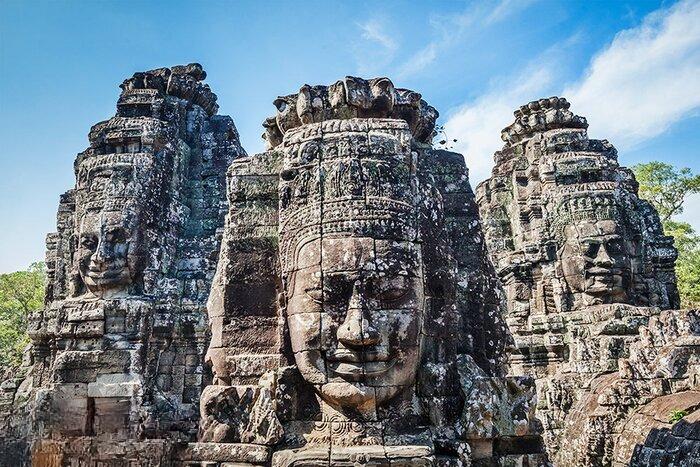
In addition, Bayon Temple in cambodia temple complex also has a structure consisting of four surrounding walls, inside each wall is a different area, including the entrance gate, tower, ritual space, courtyard, shrine, and many connecting corridors. With unique beauty and profound historical significance, Bayon Temple is one of the architectural masterpieces of Khmer civilization and one of the world heritage sites recognized by UNESCO. The temple attracts many tourists to visit and admire its ancient and mysterious beauty.
4. Ta Prohm
Imagine entering a forgotten jungle kingdom, where trees overwhelm ancient stone towers and emerald vines snake through crumbling corridors. That's Ta Prohm Temple, Cambodia's atmospheric ruins that will transport you to a world straight out of Indiana Jones. Dubbed the "Tomb Raider Temple" after Angelina Jolie's famous adventure, Ta Prohm is not your typical sleek monument.
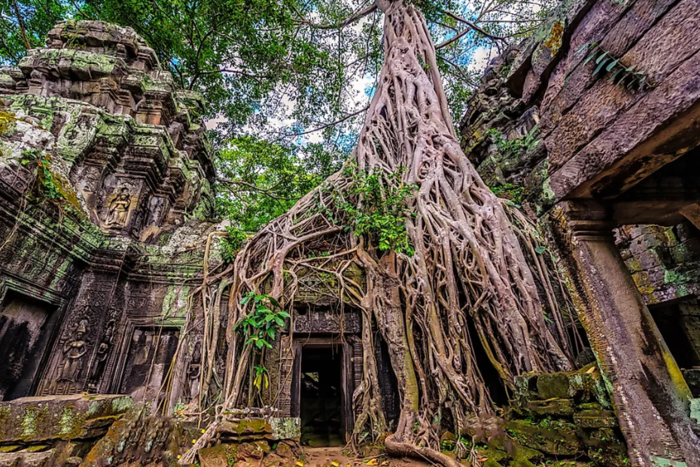
Built in the 12th century, this majestic complex was once a thriving Buddhist monastery and university. However, after the decline of the Khmer Empire, it was swallowed by the rainforest. Instead of clearing the jungle, archaeologists decided to preserve this unique combination of nature and history. The result is a breathtaking combination of ruined stone galleries, towering cottonwood trees whose roots cling to the ruins like giant tentacles, and hidden courtyards that sparkle with sunlight... So put those guidebooks away and prepare to be amazed. Wander through overgrown paths, discovering ancient carvings covered in these amazing layers of moss.
5. Banteay Srei in Angkor Temple Complex
Tucked away amidst the vast Angkorian complex lies Banteay Srei, a jewel unlike any other. Unlike the grand sandstone giants that dominate Angkor, Banteay Srei whispers its beauty in a symphony of rose-colored stone. Built in the 10th century, this Hindu temple dedicated to Shiva and Parvati is a masterpiece of intricate carvings, earning it the nickname "Citadel of the Women" for the delicate touch it exudes.
Every surface in Banteay Srei tells a story. Delicately carved scenes from Hindu epics like the Ramayana and Mahabharata dance across the walls, while celestial beings and mythical creatures peek out from the lintels and frieze, with intricate floral motifs, lifelike figures, and even depictions of everyday life etched with astonishing precision. Sunlight filtering through the gopurams casts shifting shadows on these stories, adding a touch of magic to the already enchanting atmosphere.
6. Rolous Group Temples
Nestled amidst the Cambodian jungle, 13 kilometers east of the famed temple complex in cambodia, lies the quieter charm of the Rolous Temples. This trio of ancient wonders – Bakong, Lolei, and Preah Ko – predates Angkor by a century, whispering tales of the Khmer Empire's early days. Imagine towering Bakong, a majestic five-tiered mountain temple rising from the emerald foliage, its sandstone facade glowing with the golden hues of sunrise. Nearby, Lolei and Preah Ko, adorned with intricate carvings and serene courtyards, offer glimpses into the artistic and spiritual life of this bygone era. A visit to the Rolous Temples is like stepping back in time, a chance to witness the nascent genius of Khmer architecture before it blossomed into the monumental grandeur of Angkor. So, escape the throngs of tourists and embark on a journey to these serene sanctuaries, where history whispers in the rustling leaves and ancient stones reveal the secrets of a forgotten empire.

IV. Some useful tips for visiting the Cambodia Temple Complex
Dress modestly: Angkor Wat is a sacred site, so dress respectfully. Cover your knees and shoulders, avoiding revealing attire. Opt for breathable, comfortable clothing, as exploring will involve walking and climbing...
Sunrise or Sunset: Experience the magic of Angkor Wat bathed in the golden light of dawn or dusk.
Respect the Site: Treat the site with reverence. Avoid touching ancient carvings or climbing on structures. Remember, you're a guest in this historical haven.
Bonus Tip: Immerse yourself in the local culture by attending a traditional Apsara dance performance in Siem Reap.
Immerse Yourself in Culture: Siem Reap, the gateway to Angkor Wat, offers a vibrant cultural experience. Immerse yourself in the beauty of Apsara dance, a traditional Cambodian performance that tells ancient stories through graceful movements and elaborate costumes.
Visiting the
Angkor Temple Complex in Cambodia is a journey of discovery. By planning your trip wisely and following these tips, you'll be rewarded with an unforgettable experience that will stay with you long after you leave the jungle behind. So, pack your sense of wonder, lace up your walking shoes, and let
Autour Asia transport you to a world of ancient grandeur and timeless beauty.
.jpg)

